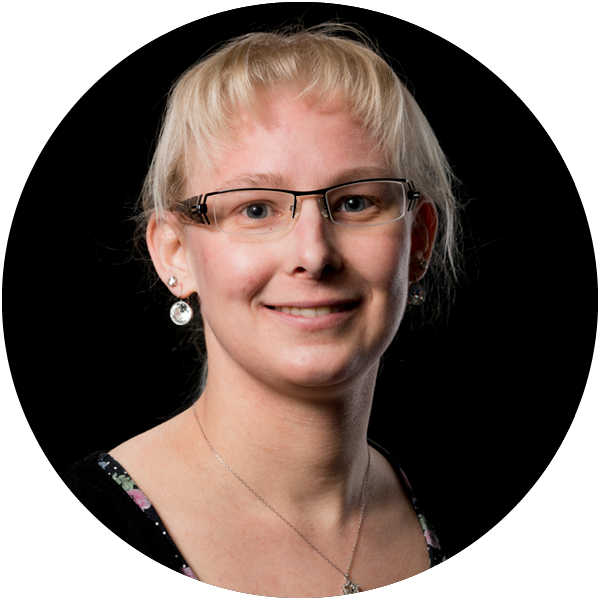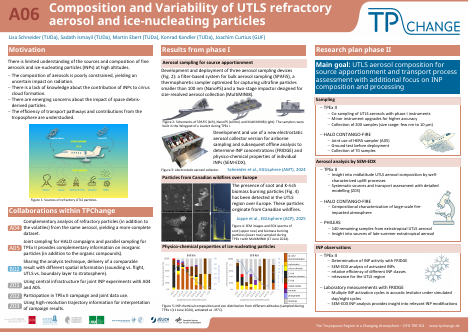
Project A06:
Composition and variability of UTLS refractory
aerosol and ice-nucleating particles
Brief Summary
Aerosols in the Upper Troposphere–Lower Stratosphere (UTLS) originate from extraterrestrial and terrestrial sources or form secondarily in the atmosphere. Refractory particles, mainly derived from space or the Earth’s surface, provide surfaces for key heterogeneous reactions. This project aims to achieve artefact-free sampling of UTLS aerosol particles and to characterize refractory particles using off-line electron microscopic individual particle analysis (EMIPA). Transmission Electron Microscopy (TEM), Scanning Electron Microscopy (SEM), and Environmental Scanning Electron Microscopy (ESEM) will be used to determine elemental composition, mineral phases, mixing state (internal/external mixtures, coatings, inclusions), volatility, and aging. Based on this dataset, source apportionment will clarify the major pathways of particulate matter into the UTLS, elucidating how surface emissions affect UTLS aerosols, how significant meteoric smoke is, how particles are modified, and how their composition influences optical properties and the radiation budget.
A second airborne sampling system will support off-line physicochemical characterization of the ice-nucleating properties of UTLS aerosol particles. Ice-nucleating behavior and physicochemical features will be analyzed using the combined Frankfurt Ice Nucleation Experiment (FRIDGE) and ESEM method. First, FRIDGE determines ice-nucleating activity under varying temperatures and humidities, enabling estimates of potential ice-nucleating particle (INP) concentrations in the UTLS. Second, each identified INP is examined in the ESEM to reveal its size, composition, and mixing state. These investigations will help determine which INPs exist in the UTLS and whether they significantly influence cloud formation, particularly cirrus development.
Project Poster
Evaluation Poster Phase I in 2025
Members

Prof. Dr. Martin Ebert
Principal Investigator
Technische Universität Darmstadt, Institut für Angewandte Geowissenschaften
mebert[at]geo.tu-darmstadt.de

Prof. Dr. Konrad Kandler
Principal Investigator
Technische Universität Darmstadt, Institut für Angewandte Geowissenschaften
kandler[at]geo.tu-darmstadt.de

Lisa Schneider
Doctoral Candidate
Technische Universität Darmstadt, Institut für Angewandte Geowissenschaften
lisa_maria.schneider[at]tu-darmstadt.de

Former Member Phase I:
Sadath Ismayil
Doctoral Candidate
Technische Universität Darmstadt, Institut für Angewandte Geowissenschaften
Publications
Bozem, H., P. Joppe, Y. Li, N. Emig, A. Afchine, A. Breuninger, J. Curtius, S. Hofmann, S. Ismayil, K. Kandler, D. Kunkel, A. Kutschka, H.-C. Lachnitt, A. Petzold, S. Richter, T. Röschenthaler, C. Rolf, L. Schneider, J. Schneider, A. Vogel, and P. Hoor (2025): The TropoPause Composition TOwed Sensor Shuttle (TPC-TOSS): a new airborne dual platform approach for atmospheric composition measurements at the tropopause. Atmospheric Measurement Techniques 18 (22), 6545–6568. doi: 10.5194/amt-18-6545-2025.
Joppe, P., J. Schneider, J. Wilsch, H. Bozem, A. Breuninger, J. Curtius, M. Ebert, N. Emig, P. Hoor, S. Ismayil, K. Kandler, D. Kunkel, I. Kurth, H.-C. Lachnitt, Y. Li, A. Miltenberger, S. Richter, C. Rolf, L. Schneider, C. Schwenk, N. Spelten, A. L. Vogel, Y. Cheng, and S. Borrmann (2025): Transport of Biomass Burning Aerosol into the Extratropical Tropopause Region over Europe via Warm Conveyor Belt Uplift. Atmospheric Chemistry and Physics 25 (21), 15077–15103. doi: 10.5194/acp-25-15077-2025.
Ebert, M., R. Weigel, S. Weinbruch, L. Schneider, K. Kandler, S. Lauterbach, F. Köllner, F. Plöger, G. Günther, B. Vogel, and S. Borrmann (2024): Characterization of refractory aerosol particles collected in the tropical upper troposphere-lower stratosphere (UTLS) within the Asian Tropopause Aerosol Layer (ATAL). Atmospheric Chemistry and Physics 24 (8), 4771-4788. doi: 10.5194/acp-24-4771-2024.
Schneider, L., J. Schrod, D. Weber, H. Bingemer, K. Kandler, J. Curtius, and M. Ebert (2025): Analyzing the chemical composition, morphology, and size of ice-nucleating particles by coupling a scanning electron microscope to an offline diffusion chamber. Atmospheric Measurement Techniques 18 (19), 5223–5245. doi: 10.5194/amt-18-5223-2025.
Schrod, J. and H. G. Bingemer (2025): A view on recent ice-nucleating particle intercomparison studies: why the uncertainty of the activation temperature matters. Atmospheric Measurement Techniques 18 (12), 2591–2605. doi: 10.5194/amt-18-2591-2025.


